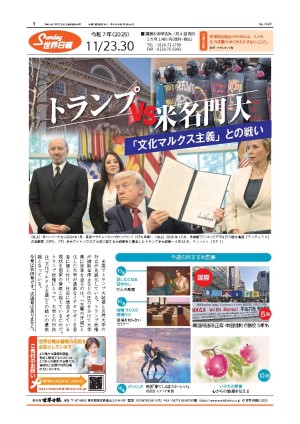米上院、トランプ氏指名の連邦高裁判事を記録的ペースで承認 Senate on record pace to pack appeals courts with Trump nominees
トランプ米大統領は、大きな影響力を持つ連邦高裁判事の人事で29人の指名が承認され、記録を更新している。高裁判事人事は、司法を改めようとするトランプ氏にとって最高裁以上に有益なものだ。
地裁判事の人事では、過去数十年の大統領の中では中位くらいにランクし、インパクトは小さい。また、最高裁判事では2人の指名を承認にこぎつけた。
リベラル派の活動家や上院民主党が、極端な遅延戦術を用いて司法へのトランプ氏の影響力を制限しようとするなど、激しい抵抗に遭う中でこの人事のペースは保守派にとって大勝利だ。
1期目のこの時点で、高裁判事人事で20人以上を記録したのは、他に1990年のブッシュ(父)大統領だけで、トランプ氏より7人少ない。
「主にトランプ政権は高裁判事人事を最優先にしている。これは正しい戦略だ」。保守派団体「司法のための委員会」のカート・リービー会長は、こう語った。
13カ所ある連邦高裁には179人の判事がおり、地裁と最高裁の中間という重要な位置にある。最高裁判事が口頭弁論を聞くケースは年間80件にすぎないため、高裁が重い法的任務を負っている。高裁の判決は、米国の各地域で銃の権利や移民などの問題をめぐり前例をつくることになる。
最前線となるのは地裁だが、ここではトランプ氏は承認を得るペースが遅い。
トランプ氏の地裁判事人事は53人で、クリントン大統領の107人、ケネディ大統領の99人と比べて大きく遅れている。またレーガン、ブッシュ(子)両大統領よりも遅れている。ただ、1期目のこの時点で地裁判事人事が30人にとどまったオバマ大統領よりは、はるかに進んでいる。
全体として、合衆国憲法第3条に基づく計870人の判事うち、トランプ氏が起用した地裁、高裁、最高裁判事は84人になる。空席は132残っている。
84人という数は、2010年10月中旬時点で43人だったオバマ氏のほぼ2倍だ。
トランプ氏が成功を収めている主な理由は、上院共和党、特にミッチ・マコネル院内総務とチャック・グラスリー司法委員長が、オバマ氏の任期最終年に最高裁などの空席を埋めなかったからだ。
「ピープル・フォー・ザ・アメリカンウェイ(アメリカ流のための人々)」のマージェ・ベイカー上級副代表は、共和党は上院議員たちに判事候補をしっかり審査する十分な時間を与えない「意地悪なペース」で承認を続けている、と指摘した。
ベイカー氏は、トランプ氏が指名した地裁判事候補には、公聴会で判事になる準備ができていないことを露呈し、撤回を余儀なくされた人が数人いたことを指摘した。
ベイカー氏はまた、11、12月に目を向けた。上院は中間選挙後の何もできないレームダック会期に戻ってくる予定だが、共和党は数十人の判事候補を本会議の採決にかける準備を進めている、と指摘した。
「民主党がこのペースを遅らせるためにもっと議論が必要だと主張し、自由に使える手続き上のあらゆる手段を用いることを期待する」と、ベイカー氏は語った。
もし民主党が判事候補1人につき最大限の時間を費やすことを強いれば、上院は他の重要な議事を進めることができずに、5人の判事の承認に丸1週間かかってしまう。
(10月17日付)
President Trump is smashing the record for appointing judges to the powerful federal appeals courts with 29 picks confirmed, helping him put his stamp on the judiciary well beyond the Supreme Court.
He has had less of an impact on the lower district courts, where he ranks near the middle with his predecessors of the past few decades. He also has had two Supreme Court nominations confirmed.
For conservatives, the pace of action is a major victory, particularly in the face of overwhelming opposition from liberal activists and Senate Democrats, who have used extreme delaying tactics to try to limit Mr. Trump’s influence on the shape of the courts.
President George H.W. Bush, the only other president to have broken the 20-judge mark at this point in his first term, had seven fewer than Mr. Trump in 1990.
“For the most part, they have prioritized appeals court nominees, and that is the right strategy,” said Curt Levey, president of the conservative Committee for Justice.
The 13 circuit courts of appeals, which have 179 judgeships, are the key middle ground between the district and the Supreme Court. With the justices hearing oral arguments in perhaps only 80 cases a year, that leaves much of the heavy legal lifting in the circuit courts, where rulings set precedent on issues such as gun rights and immigration in their respective parts of the country.
District courts are the front lines, and there Mr. Trump has been slower in winning confirmations.
His 53 district judges place him well behind President Clinton, with 107, and President Kennedy, with 99. He also is behind Presidents Reagan and George W. Bush - though well ahead of President Obama’s 30 district judges at this point in his term.
All told, Mr. Trump has appointed 84 judges to the district, circuit and high courts out of a total of 870 Article III judgeships. There remain 132 vacancies.
The 84 appointments are nearly double the 43 that Mr. Obama had as of mid-October 2010.
Mr. Trump has been largely successful because Senate Republicans - particularly Majority Leader Mitch McConnell and Judiciary Committee Chairman Chuck Grassley - kept a Supreme Court seat and other vacancies unfilled in the final year of Mr. Obama’s tenure.
Marge Baker, executive vice president of the People for the American Way, said Republicans have kept up a “wicked pace” of confirmations that doesn’t give senators enough time to fully vet nominees.
She pointed to several Trump picks for district courts who had to withdraw after their lack of preparation for judgeships became clear during their hearings.
Ms. Baker also cast an eye to November and December. The Senate is slated to return for a lame-duck session after the midterm elections, and Republicans have teed up dozens more judges for possible floor votes.
“I expect Democrats to be insisting on significantly more debate and using whatever procedural tools they have at their disposal to slow this down,” Ms. Baker said.
If Democrats force the maximum amount of time per nominee, it can take the Senate an entire week, with no other major floor business transacted, to confirm five judges.
October 17, 2018





